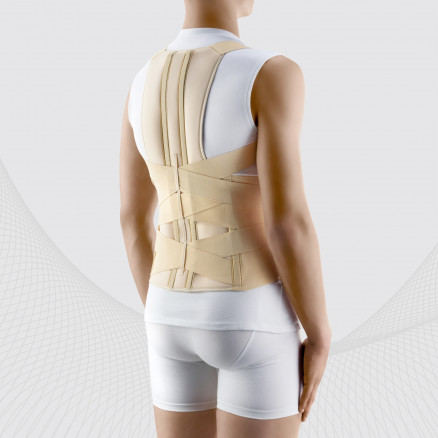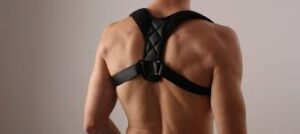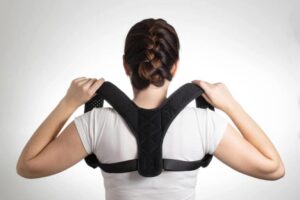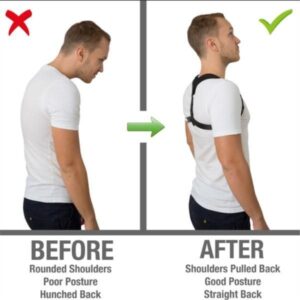

If you are still wondering “Can a Posture Corrector Really Fix Forward Head Posture?” then, reading this article may provide the missing “key” to your burning query.
Have you ever found yourself leaning so far forward at your desk that you resemble a human bobblehead?
If so, you’re in good company!
In this article, BestForwardHeadPostureFix experts are tackling the ever-so-common forward head posture and exploring whether a posture corrector can truly set things straight.
We shall break down what forward head posture is, how these nifty devices work, and get the lowdown from experts.
Plus, we will help you choose the best posture corrector for your needs.
So, get ready to sit up straight and dive into a fun and informative guide to fixing that pesky posture problem!
Article Index: “Can a Posture Corrector Really Fix Forward Head Posture”
- Introduction
- Understanding Forward Head Posture
- What is Forward Head Posture?
- Common Causes of Forward Head Posture
- How Posture Correctors Work?
- Types of Posture Correctors
- Mechanism of Action: How Do They Help?
- The Science Behind Posture Correctors
- Studies Supporting Their Use
- Limitations of Posture Correctors
- Expert Opinions on Posture Correctors
- What Do Doctors Say?
- Insights from Physical Therapists
- Are Posture Correctors a Long-Term Solution?
- Benefits and Drawbacks
- Complementary Exercises and Practices
- How to Choose the Right Posture Corrector
- Factors to Consider
- Popular Brands and Reviews
- FAQs on Posture Corrector for Neck Posture
- Conclusion: Do Posture Correctors Really Work?
Introduction
We’ve all been there—hunched over our desks or slumped on the couch, completely unaware that our posture is doing us no favors.
And then, boom!
A photo, a mirror, or that nagging neck pain reminds us that our heads are practically leading our bodies around like a bobblehead doll.
Enter the posture corrector: a simple device promising to pull your shoulders back, realign your spine, and banish forward head posture (FHP) forever.
But does it really work?
Can a posture corrector truly fix forward head posture, or is it just another band-aid solution?
Let’s dive in and find out what the experts have to say.
Understanding Forward Head Posture
Forward head posture, often called “text neck” or “turtle neck,” occurs when your head juts forward, out of alignment with your spine.
Imagine looking at your side profile in a mirror. Ideally, your ear should be in line with your shoulder.
However, if you notice your head leaning forward, you’ve got a case of FHP.
This posture is more than just an aesthetic issue; it puts unnecessary strain on your neck, shoulders, and upper back, potentially leading to chronic pain and other complications.
Common Causes of Forward Head Posture
Our modern lifestyle is largely to blame for the rise in forward head posture cases.
Prolonged use of smartphones, tablets, and computers forces us to lean our heads forward, disrupting the natural curve of our spine.
Poor ergonomics at workstations, slouching while watching TV, and even certain sleeping positions can contribute to this postural issue.
Over time, these habits cause the muscles at the front of your neck to tighten, while those at the back weaken, leading to a self-perpetuating cycle of poor posture.
How Posture Correctors Work?
Think of posture correctors as your personal posture police—they gently nudge your shoulders back into place, reminding your head it’s not meant to lead like a runaway train!
Let’s find out more about them:
Types of Posture Correctors
Posture correctors come in various shapes and sizes, from simple elastic bands that pull your shoulders back to more complex braces that support your entire upper back and neck.
The most common types include:
- Shoulder Braces: These pull your shoulders back, aligning them with your spine.
- Clavicle Straps: These are similar to shoulder braces but more focused on the upper chest and shoulders.
- Full Back Braces: These cover your entire upper back and sometimes even the lower back, offering more comprehensive support. Some prefer using posture corrector bands as well.
- Electronic Posture Trainers: These devices vibrate when you slouch, reminding you to straighten up.
Mechanism of Action: How Do They Help?
The primary function of a posture corrector is to retrain your muscles to maintain proper alignment.
By pulling your shoulders back and aligning your spine, these devices reduce the strain on your neck and back muscles, encouraging a more natural posture.
Over time, consistent use of a posture corrector can help strengthen the muscles responsible for maintaining this alignment, making it easier to sit and stand with good posture even when you’re not wearing the device.
The Science behind Posture Correctors
Posture correctors aren’t just gadgets—they’re like brain trainers for your muscles, helping you ditch bad habits and stand tall.
First learn to attach posture correctors correctly to your body in order to avail the best benefits from them.
Science says they are legit, but remember, muscles love doing their own thing too!
Studies Supporting Their Use
Research on posture correctors is still emerging, but some studies do support their effectiveness.
For example, a study published in the Journal of Physical Therapy Science found that participants who used posture-correcting braces showed significant improvement in their spinal alignment and a reduction in musculoskeletal pain.
Another study in the Journal of Back and Musculoskeletal Rehabilitation demonstrated that posture correctors could reduce the forward head angle in participants, leading to decreased neck strain and discomfort.
Limitations of Posture Correctors
However, it’s important to note that posture correctors are not a cure-all.
Some experts argue that while these devices can temporarily improve posture, they don’t address the underlying muscle imbalances that cause FHP.
Over-reliance on a posture corrector might even weaken your muscles over time, as they begin to rely on the device for support instead of maintaining the alignment on their own.
So, you can try and make changes to your current lifestyle, such as sleeping in the correct posture to avoid turtle neck.
Expert Opinions on Posture Correctors
Experts give posture correctors a thumbs-up, but with a wink—they’re helpful, but only if you don’t let your muscles get too lazy. Think of them as a gentle reminder, not a crutch!
What Do Doctors Say?
Medical professionals often have mixed opinions on posture correctors.
Dr. Vinh Pham, a physical therapist and co-founder of Myodetox Clinics, points out that while posture correctors can provide immediate relief and support, they are most effective when used as part of a comprehensive treatment plan.
He emphasizes the importance of combining the use of posture correctors with exercises that strengthen the neck, back, and shoulder muscles to achieve long-term results.
When you are sitting on a chair, you need to learn how to position a posture corrector strap to fix neck posture.
Insights from Physical Therapists
Physical therapists generally agree that posture correctors can be useful, especially for individuals who struggle to maintain proper posture due to weakness or pain.
However, they also stress the importance of active posture correction through exercises.
For instance, simple exercises like chin tucks, shoulder blade squeezes, and thoracic extensions can complement the use of a posture corrector and help reinforce good posture habits.
Are Posture Correctors a Long-Term Solution?
Posture correctors are like training wheels for your back—great for learning, but not something you want to rely on forever. They help, but you’ve got to build that muscle memory too!
Benefits and Drawbacks
The benefits of posture correctors are clear: they provide immediate support, reduce pain, and can help correct FHP when used properly.
However, they also have their drawbacks.
Relying solely on a posture corrector without addressing the root causes of FHP—like muscle weakness or poor ergonomics—may result in only temporary improvement.
Moreover, overusing these devices can lead to muscle dependency, where your body becomes reliant on external support instead of developing the strength to maintain proper posture on its own.
Complementary Exercises and Practices
To get the most out of a posture corrector, it’s essential to combine its use with exercises that target the muscles involved in maintaining good posture.
Some effective exercises include:
- Chin Tucks: This exercise helps strengthen the deep cervical flexors, which are crucial for keeping your head aligned with your spine.
- Shoulder Blade Squeezes: This movement strengthens the muscles between your shoulder blades, promoting better shoulder alignment.
- Thoracic Extensions: These exercises improve mobility in your upper back, counteracting the stiffness that often accompanies FHP.
In addition to exercises, practicing good ergonomics at your workstation and being mindful of your posture throughout the day are key to preventing and correcting forward head posture.
How to Choose the Right Posture Corrector?
Choosing a posture corrector is like picking the perfect outfit—comfort, style, and support all matter! Find one that’s comfy, discreet, and gives your slouchy shoulders a stylish nudge.
Factors to Consider
When choosing a posture corrector, there are several factors to keep in mind:
- Comfort: The device should be comfortable enough to wear for extended periods. Look for adjustable straps and breathable materials.
- Support Level: Consider how much support you need. Those with severe FHP might benefit from a full back brace, while others might find a shoulder strap sufficient.
- Discreetness: If you plan to wear your posture corrector under clothing, opt for a model that is slim and discreet.
- Ease of Use: Some posture correctors are easier to put on and adjust than others. Make sure you choose one that fits your lifestyle.
Popular Brands and Reviews
Several brands are known for producing high-quality posture correctors. Some popular options include:
- BackEmbrace: Known for its comfortable and stylish designs, BackEmbrace offers posture correctors that are both functional and discreet.
- Upright GO: This electronic posture trainer vibrates when you slouch, making it a great option for those who prefer real-time feedback.
- Evoke Pro A300: A popular choice for its full back support and adjustability, making it suitable for both mild and severe FHP.
When choosing a posture corrector, it’s also helpful to read user reviews to understand the pros and cons of each model.
FAQs on Posture Corrector for Neck Posture
Q1: Can posture correctors alone effectively fix forward head posture?
A1: Posture correctors can help by providing reminders to maintain proper alignment, but they are not a complete solution on their own. Experts agree that combining the use of posture correctors with exercises to strengthen neck and upper back muscles is essential for lasting improvement in forward head posture.
Q2: Are there potential downsides to wearing posture correctors for extended periods?
A2: Yes, wearing posture correctors excessively can lead to muscle dependency, where the muscles responsible for supporting posture weaken instead of strengthening. It is generally recommended to limit wear time to short intervals, such as 30 to 60 minutes, to avoid this risk.
Q3: How do posture correctors compare with targeted therapeutic exercises in treating forward head posture?
A3: Posture correctors serve primarily as a physical reminder to maintain good posture, while therapeutic exercises actively address the underlying muscle imbalances causing forward head posture. Exercise programs tend to produce more significant and lasting improvements in posture and reduce associated neck pain.
Q4: Can a posture corrector replace the need for physical therapy?
A4: No, posture correctors should not be considered a substitute for professional physical therapy. They are more effective when used as a supplementary tool alongside a comprehensive therapy regimen that includes exercises designed to correct muscle imbalances and improve posture mechanics.
Q5: What should one look for when choosing a posture corrector for forward head posture?
A5: It is important to select a posture corrector that focuses on aligning the neck and upper back comfortably and fits well. Consulting a healthcare professional can help ensure the device is suitable for an individual’s specific posture needs and provides the best support without causing discomfort.
Do Posture Correctors Really Work?
So, can a posture corrector really fix forward head posture? The answer is yes—but with some caveats.
Posture correctors can be a valuable tool in the battle against FHP, providing immediate support and helping to retrain your muscles.
However, they are most effective when used as part of a broader approach that includes exercises, ergonomic adjustments, and mindfulness of your posture throughout the day.
In short, a posture corrector can certainly help, but it’s not a magic fix.
To achieve lasting results, you’ll need to put in the work to strengthen your muscles, improve your habits, and make conscious choices about how you hold yourself.
With a little effort and the right tools, you can say Goodbye to Forward Head Posture and hello to a healthier, more aligned you.
References:



